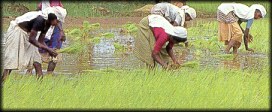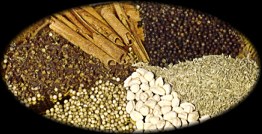  |  |
|
| A number of religions, with their own traditions and customs, co-exist in India. The food habits differ across regions, religions. However, the two cultures that have played a pivotal role in the development of the Indian cuisine and food habits are the Hindu and the Muslim traditions. The Portuguese, the Persians and the British have also made important contributions to the Indian cuisine scene.
The vegetarian tradition is widespread in India. Mughlai food, that include kababs, rich curries and meatballs, the biryani - a rice and meat preparation, and tandoori chicken are important contributions made by the Muslim settlers in India. India also offers a wide range of continental food.  Just as there is no single style of Indian cooking, there is no single national dish. Styles of cooking and commonly used ingredients differ from region to region, and from one household to another. Rice is the staple diet of India. Just as there is no single style of Indian cooking, there is no single national dish. Styles of cooking and commonly used ingredients differ from region to region, and from one household to another. Rice is the staple diet of India.
 Gravy based dishes are prominent throughout India but they are different from one another. The essence of Indian cooking revolves around the use of spices. Spices serve both as appetizers and digestives. Kerala is famous for spices. Pepper is the king of Kerala's spices, but the state also has a rich produce of cardamom, cinnamon, nutmeg, cloves, mace, ginger and turmeric. Gravy based dishes are prominent throughout India but they are different from one another. The essence of Indian cooking revolves around the use of spices. Spices serve both as appetizers and digestives. Kerala is famous for spices. Pepper is the king of Kerala's spices, but the state also has a rich produce of cardamom, cinnamon, nutmeg, cloves, mace, ginger and turmeric.
The other main ingredients of Indian cooking are the milk products - ghee and curd. Dals or pulses are also used across the country. Vegetables differ across regions and with seasons. The style of cooking vegetables is dependent upon the main dish or cereal with which they are served. The Indian cuisine includes a host of beverages, desserts and paan for a grand finale. |
| About India | Arts | Cuisine | Fairs | Festivals | Neighbours | Society | Religions |
| Site Map | Disclaimer | About Us | Write To Us |
